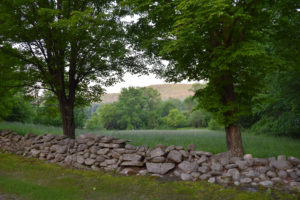
Sermons in Stone
Take a moment to consider the labors of your workday—of all that you do, what evidence of it will remain in two or three hundred years? Needless to say, there will be very little. By contrast, the old Yankee farmers of New England will be long remembered for their diligent, honest work ethic, thanks to the stone walls they have left to us.
Those walls are symbolic of our region; in fact, it can be said that the history of New England is written in stone. Pick any two places on a map and drive from one to the other; along the way you you’re likely to see miles upon miles of stone walls surrounding the planting-fields of yesteryear. They crisscross the landscape, traveling over streams, through swamps, over large stone outcrops, down hills and forested countryside. This is all pretty remarkable when you consider that two men and a team of oxen could only build about ten feet of stone wall per day! In 1871, roughly one-third of Connecticut’s fences were made of stone, and they totaled over 20,000 miles; indeed, at that time, all the stone walls in New England, placed end-to-end, would have reached all the way from the earth to the moon!
But the farmers of New England didn’t build those stone walls as monuments to themselves; rather they built them as demarcation lines and linear landfills. Rock-picking was every New England farmer’s springtime misery. During the winter as the earth froze and thawed, rocks would rise to the surface of the fields; it was a practical necessity to remove them before plowing could proceed. And as a result of the advancing deforestation of New England, it was impossible to make use of wooden fences anyway.
Removal of these stones was performed with the help of a device called a stone boat and a yoke of oxen (an ox is a neutered bull). Each stone would be levered onto the stone boat and skidded to the edge of the field, there to become part of the wall. The hidden secret to these walls’ longevity is this: the broad, stabilizing foundation of the wall extended a full two feet below the surface of the field! This protected the walls from being thrown down by frost heaves.
The evolution of “dry” (mortarless) walls, as they are known, went in stages:
–The first and most primitive walls were know as “thrown walls” or “dumped walls”; they consisted merely of rocks heaped one on top of another in a haphazard fashion.
–Next came “stacked walls”; these reflected advanced farm development in the region, and had a more orderly appearance.
–Later came “laid walls”, which emphasized stability and beauty; these are often found near town centers, public buildings, and the homes of yesterday’s wealthy landholders. They feature a tightly fitted mix of large and small stones, and are topped by tablet-shaped stones known as capstones. Entryways are marked by long, angular grayish slabs, set on end, and extending above the level of the wall itself.
These stone walls are still important for marking property lines, but they also remind us of our region’s past; for this reason they must be preserved. However, a growing demand exists for the harvesting of fieldstones from stone walls, to then be used to mark the boundaries of new tracts of land, in neighborhood subdivisions. It is sad indeed to see history being removed in service of such needs; let’s hope this trend doesn’t continue.